Handball exercises for u7
- This is best restricted to inside the 6 meters area.
- This game is best played with the same number of players in both teams.
- Make it harder by making the play between the 6 and 9 meters and the defenders can only do side step/shuffle Objective of the game:
- get the youth used to contact in handball Divide the players in two teams with roughly equal numbers and abilities (don't put all the big and good players in one team and the rest in the other)
- The players play the 10 pass game.
- No passbacks allowed.
- The defending team will try to stop the attacking team by placing 2 hands on their chest and arm and holding (measure the level of aggressiveness and adjust).
- If they are successful it's a turnover.
- Then start over with the same rules.
- Make it harder by instead of being two hands, being a tactical defence hug and holding 3 seconds.
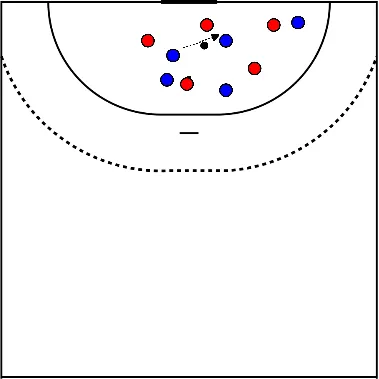
- This is best restricted to inside the 6 meters area.
- This game is best played with the same number of players in both teams.
- Make it harder by making the play between the 6 and 9 meters and the defenders can only do side step/shuffle Objective of the game:
- get the youth used to contact in handball Divide the players in two teams with roughly equal numbers and abilities (don't put all the big and good players in one team and the rest in the other)
- The players play the 10 pass game.
- No passbacks allowed.
- The defending team will try to stop the attacking team by placing 2 hands on their chest and arm and holding (measure the level of aggressiveness and adjust).
- If they are successful it's a turnover.
- Then start over with the same rules.
- Make it harder by instead of being two hands, being a tactical defence hug and holding 3 seconds.
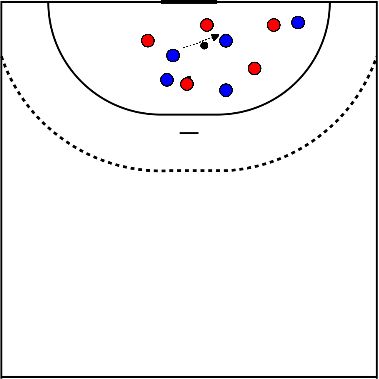
This can make use of an existing outline of a badminton field's lines, or be created with cones.
This serves 3 purposes:
This serves 3 purposes:
- Passing
- Moving to receive the ball
- Defense
- You will need 3 pairs of players.
- Two pairs on opposite ends of the delimited area trying to pass the ball to each other, and one pair in the middle intercepting.
- The pairs on each end, can not pass to their partner, they have to pass to the other pair at the other side of the court.
- They can not pass the centre point.
- The defending pair will either try to touch the person with the ball, or to intercept the pass.
- Once the defending team succeeds in one of these, then they swap.
- If the pass is out of bounds, they also swap.
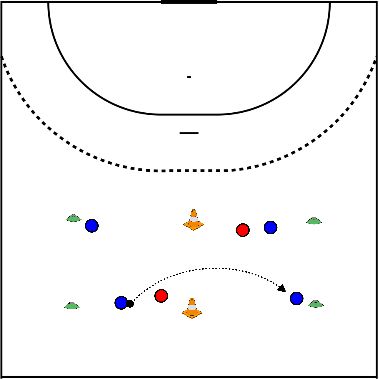
This is a resistance and mental strength exercise.
- Each player goes to their position. They will have to take 3 - 5 shots in a row, running back to the position as soon as they shoot. For every two shots, they will have to change the third shot.
- The objective, more than building resistance, is to build mental strength to make the body go forward when we're tired.
- This will be repeated several times.
- The first couple of times the players won't be tired, but after the third or fourth repetition of the series of shots in a row, then they will.
- There can also be one player (pivot for example) blocking shots (not 100% defense, just 30%)
- If the overall team scores more than 50% than the keeper does 20 push ups, 20 sit ups, and 20 squats.
- If the team scores less than, then the team does it.
- Make 6 or 8 columns of players (at least 2 in each column).
- They will have 2 balls in play, with some time distance. (wait until the first ball reaches the middle point and then the second ball starts being passed around)
- The players will have to pass the ball and run to the column they just passed the ball to.
- They will have to be running when they pass the ball, and change passes after a while (normal, bounce, side, underarm,...)
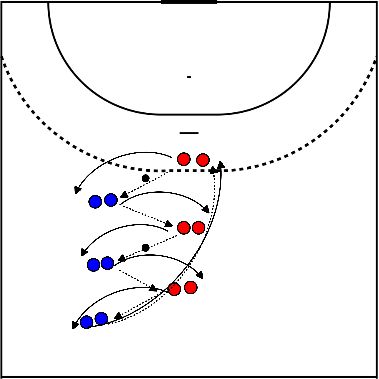
The players form a line at one end of the court.
- The 2nd player on the line passes the ball to the coach who will be between the centre of the court and the 12 meters.
- The 1st player on the line runs as soon as the pass is made.
- The coach will then pass the ball to the front of the 1st player who is running towards the opposite goal to receive the ball.
- The pass will not be towards the player's hands, but rather to a step in front of where they are, so they continue accelerating.
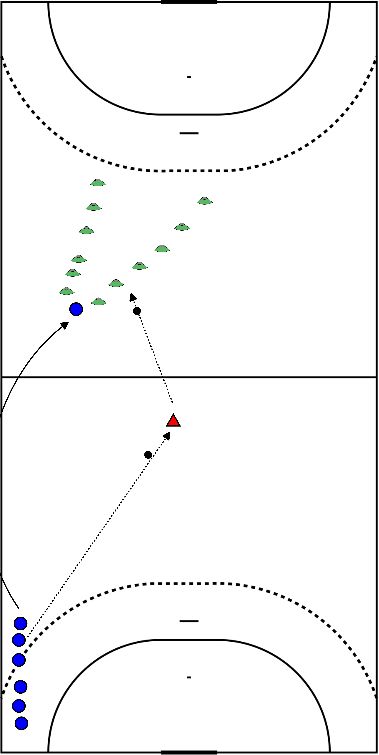
- This can be done with groups of 5 up to 9.
- Let's take a group of 7
- Delineate an area where 4 people can stand and move around with a bit (not too much) room. Place 3 defenders inside, plus 1 line/pivot.
- The remaining 3 attackers will pass the ball around outside the area, with no bounce, and they score a point by either:
- Passing the ball effectively to the pivot
- Placing the ball inside the area without being touched by a defender
- The attackers can move freely, but limited to the 3 steps, 3 seconds with ball in hand, and no bounce.
- If these rules are broken, they become the defenders.
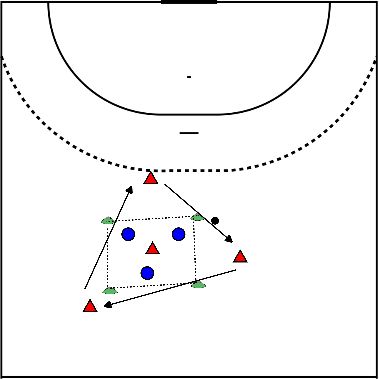
This can be done in groups of 2 or 3 players.
- This is to get used to receiving the ball in motion, facing the goal.
- This is a passing exercise as well.
- Let's take a group of 3 players.
- There will be two cones on the floor, at around 10 meters, on each side of the centre back, and 2 cones at the 7 meters in front of the half backs.
- The centre back has the ball, and for the half back to receive the ball, they need to start behind the cone of the 10 meters, and run in front of it.
- The centre back can only pass the ball in the direction after the cone. Once the half back receives the ball, they will do two/three steps towards the 7 meter cone, stop, and pass the ball back to the centre half who must start before the 10 meter cone and receive the ball after it.
- The half back then returns to their spot and the centre back continues the exercise with the other side half back.
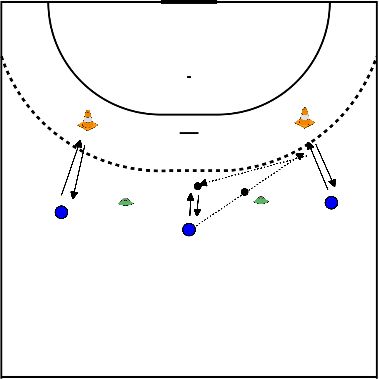
- Depending on how many players there are you can use the full 6/9 meters or just a part of it.
- The defending players will hold hands two by two (so if there are 6 players, there will be 3 groups of 2).
- The attacking players will pass the ball around between themselves and around the area trying to "destabilise" the defence and find a gap so they can run in and touch down with the ball in the area.
- If the 2 groups of the defending players touch the attacker, the point does not count.
- if only 1 of the groups of the defending players touch the attacker, the point counts.
- If none of the groups of the defending players touch the attacker, it counts 2 points.
The goal is to get to 8/10 points (depending on how many 2 points they score) and then swap.
- If there's few players, shorten the court and if there's an uneven number, the defence stays with one less.
Pay attention:
- No lob passes
- No more than 3 passes
- No bounce (if possible)
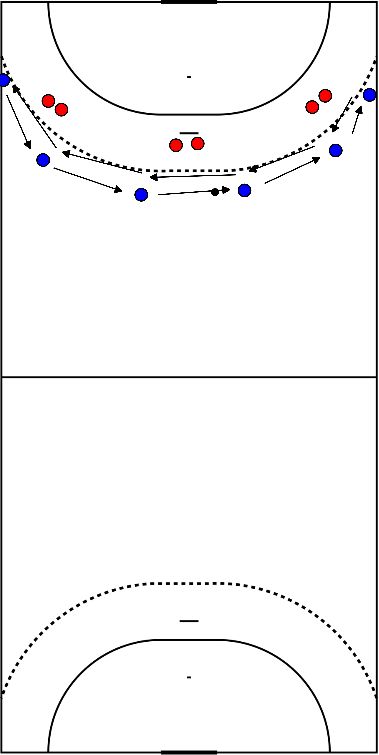
This can be done with groups of 3 to 7 - odd numbers ideally.
- Let's assume a group of 5 players.
- We'll have 3 attackers and 2 defenders.
- The 3 attackers will have a delimited running corridor in a straight line and they will have to pass the ball from one to the others while the 2 defenders will have to try and intercept the passes. The defenders have freedom of movement.
- The exercise can evolve in the types of passes in order to foster movement without the ball.
- First all types of pass, then no lob passes, then only bounce passes.
If the defenders intercept the pass, they continue the exercise acting as the attacking players in numerical inferiority. The 3 attacking players now have no restriction of movement.
This is to be done slowly at first, not as a fast break, to instill the idea of moving without the ball first. The speed can be adapted as the exercise goes on.
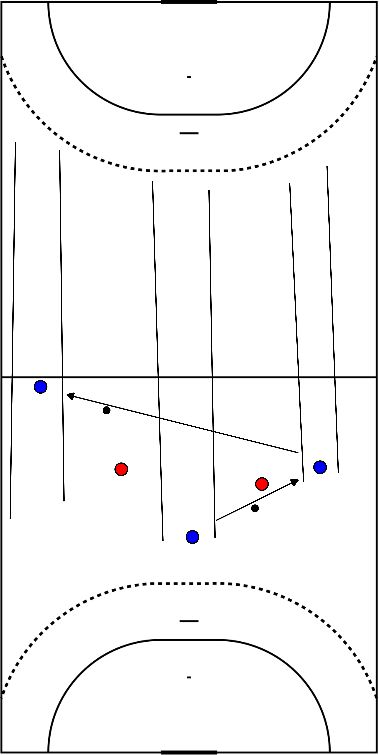
- 2 a 3 hunters throwing off players with a soft ball
- Ratio; 1 to 5.
- Head is sacred and may not be touched and play with handball rules.
- If you are thrown off you sit on the bench.
- The 2 or 3 players who are thrown off first become the hunter in the next game.
Exercise 1
- ladder; 2 feet in each section
- step; with 2 feet on the step
Exercise 2
- Ladder: 2 feet in each section
- Step: with 2 feet on and off
Exercise 3
- Ladder:
- left foot in a compartment
- right foot wide next to ladder and with slightly bent knee balance for a moment.
- left foot in next compartment and exchange with right foot
- left foot wide next to ladder and keep balance with slightly flexed knee
Step: sideways left/right between the step
Exercise 3
- Ladder:
- left foot in compartment (on forefoot!)
- touch right foot outside ladder ground and place in next section (rotating movement with body)
- then tap left foot outside ladder ground and place in next section
step; limp with 2 feet on the step
Exercise 4
- start next to ladder with toes towards ladder
- step with both feet in first section and step sideways to next section.
- then backwards again next to the ladder
- step next to ladder on side for next section and step forward again with both feet in section
Step; limp with 1 foot on step
Repeat exercise at least twice








